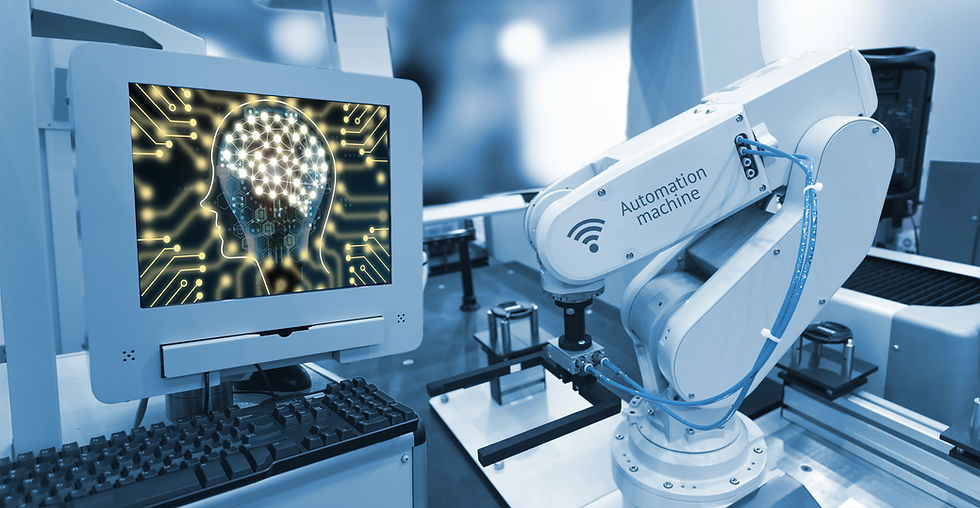Understanding BLE and its Capabilities for Indoor Localization
- Srihari Maddula
- Mar 25, 2024
- 6 min read
Updated: Oct 14
Bluetooth Low Energy (BLE), also known as Bluetooth Smart, is a wireless communication technology specifically designed for low-power applications. Its unique characteristics make it highly suitable for indoor localization:
Key Features:
Low Energy Consumption: BLE devices consume significantly less power than traditional Bluetooth devices, making them ideal for battery-powered applications such as beacons and mobile devices. This is critical when designing embedded systems for smart pole IoT integration or smart lighting systems.
Signal Strength Measurement: BLE devices can measure the Received Signal Strength Indicator (RSSI) of nearby devices, which can be used to estimate distance based on signal attenuation—a method often used in smart city solutions provider deployments.
Advertising Packets: BLE beacons broadcast advertising packets containing their unique identifiers and other data at regular intervals. Mobile devices in an IoT & embedded services India deployment can receive these to detect and locate beacons.
Connectionless Communication: BLE allows for communication without establishing a formal connection, enabling quick and efficient data exchange between beacons and mobile devices in industrial IoT and automation settings.

How BLE Enables Indoor Localization
BLE-based indoor localization systems typically involve:
BLE Beacons: Stationary devices placed at known positions in indoor spaces. They continuously broadcast advertising packets with unique identifiers and possibly sensor data. These are integral to embedded AI India deployments.
Mobile Devices: Smartphones, tablets, or BLE-enabled devices receive beacon signals. Localization algorithms process data (e.g., RSSI, AOA, AOD) to estimate device location.
Localization Algorithms: Software (on the phone, gateway, or server) that processes beacon data to compute location. In smart infrastructure solutions, this location data can feed into building automation, analytics, or GIS systems.
Advantages of BLE for Indoor Localization
Cost-effective: BLE beacons are relatively inexpensive and simple to deploy, making them attractive for indoor positioning systems in places like airports, malls, or smart buildings.
High Accuracy: BLE-based systems can achieve meter-level accuracy depending on environment, calibration, and algorithm design.
Scalability: You can scale indoor coverage by adding more beacons.
Versatility: BLE works well with other sensors and systems, enabling location tracking, environmental data collection, and interactions with smart city platforms.
Understanding BLE’s capabilities is foundational for leveraging it in smart infrastructure, digital twin smart city applications, and GeoAI-enhanced indoor systems.
AOA and AOD: Determining Direction and Location with BLE
Angle of Arrival (AOA) and Angle of Departure (AOD) are advanced techniques used in BLE indoor localization to determine directionality.
AOA
How it works: A receiver with an antenna array (e.g. smartphone, gateway) measures phase differences of the incoming BLE signal across antennas. That gives the angle of arrival, indicating direction to the beacon.
Applications: In embedded systems development for indoor positioning, AOA enables more precise localization than RSSI alone.
Challenges: Requires precise phase measurement, careful calibration, and advanced signal processing.
AOD
How it works: The BLE beacon itself has multiple antennas and transmits signals such that the mobile device analyzes phase differences to determine the angle of departure.
Use case: Helps the mobile device infer its position relative to the beacon—useful in IoT product engineering where beacons are smart and capable.
As with AOA, the calculations are complex, and hardware becomes more demanding.
Benefits:
Better accuracy and direction information compared to only using signal strength.
Helps combat multipath interference in dense environments.
Limitations:
Requires more complex hardware and calibration.
Higher computational load for phase-based algorithms.
AOA and AOD: Determining Direction and Location with BLE
Angle of Arrival (AOA) and Angle of Departure (AOD) are two powerful techniques used in BLE-based indoor localization to determine the direction and location of devices.
Angle of Arrival (AOA):
How it works: AOA utilizes an array of antennas on the receiving device (e.g., a smartphone). By analyzing the phase differences of the BLE signal arriving at each antenna, the angle of arrival can be calculated. This angle indicates the direction from which the signal is coming, allowing the receiver to determine the relative direction of the beacon.
Mathematical Calculation: AOA is typically calculated using complex mathematical formulas involving the phase differences, antenna spacing, and signal wavelength. Simplified representations of these formulas can be found in various resources, but the actual calculations often involve advanced signal processing techniques.
Angle of Departure (AOD):
How it works: AOD works in a similar way to AOA, but the roles are reversed. In this case, the BLE beacon is equipped with multiple antennas, and the mobile device receives the signal and analyzes the phase differences to determine the angle of departure. This angle indicates the direction in which the signal was transmitted from the beacon, allowing the mobile device to estimate its own location relative to the beacon.
Mathematical Calculation: Similar to AOA, AOD calculations involve complex formulas based on phase differences, antenna configurations, and signal characteristics. Advanced signal processing techniques are often employed for accurate AOD estimation.
Benefits of AOA and AOD:
Improved Accuracy: Compared to relying solely on signal strength, AOA and AOD provide additional information about the direction of the signal, leading to more accurate location estimations.
Reduced Multipath Interference: AOA and AOD techniques can help mitigate the effects of multipath interference, where the signal bounces off walls and other obstacles, creating multiple paths to the receiver.
Limitations:
Hardware Requirements: Both AOA and AOD require specialized hardware with multiple antennas, which can increase the cost and complexity of implementation.
Computational Complexity: The calculations involved in AOA and AOD can be computationally intensive, requiring more processing power on the receiving device.
Despite these limitations, AOA and AOD are valuable techniques for enhancing the accuracy and reliability of BLE-based indoor localization systems. By combining these methods with other techniques like ZOA and ZOD, even more precise and robust positioning can be achieved.

ZOA and ZOD: Adding the Vertical Dimension
While AOA/AOD help estimate horizontal location, Zone of Arrival (ZOA) and Zone of Departure (ZOD) help estimate height or floor level—important in multi-level buildings.
ZOA
Concept: Define zones at different heights or floors. Based on signal strength from beacons at known vertical positions, the receiver estimates which zone it belongs to.
Usage: Useful in building navigation where knowing the floor matters for smart infrastructure and GIS mapping for utilities deployments.
ZOD
Concept: The beacon measures or transmits signal strength observed in vertical dimension, letting the mobile device infer its height.
Implementation: More complex, especially if the beacon is to actively participate in vertical inference.
Benefits:
3D positioning (not just X and Y, but also Z).
Better performance in multi-floor or vertical-use environments.
Challenges:
Requires careful calibration and mapping of zones.
Environmental variation (walls, floors) affects signal strength.
Combining ZOA/ZOD with AOA/AOD leads to more robust 3D localization.
Combining Techniques for Enhanced Accuracy
Using one technique alone often limits performance. Hybrid approaches yield better results:
Hybrid Approaches: Combine AOA/AOD with ZOA/ZOD to estimate both horizontal and vertical position reliably.
Weighted Algorithms: Assign weights to each technique based on environment (e.g., RSSI weighting vs. angle-based).
Sensor Fusion: Use inertial sensors (accelerometer, gyroscope) on mobile devices to complement localization.
Fingerprinting: Build an RSSI signature database for different locations, and compare current signals to that database. This method integrates well with angle-based methods to reduce errors.
The best method depends on application, environment, and hardware capability.
Real-World Applications and Examples
BLE-based indoor localization, using AOA, AOD, ZOA, and ZOD, is being applied in:
Warehouse Asset Tracking: Beacons on pallets and forklifts; angle + strength techniques locate assets within warehouse zones.
Indoor Navigation in Hospitals/Malls: Use direction and floor detection to guide visitors.
Retail Location-based Services: Detect aisles for personalized notifications; helps with smart city retail analytics.
Patient Tracking: Hospitals track staff, equipment, or patients in different floors using vertical localization.
These applications benefit from combining techniques and calibration for environment-specific gains.

Challenges and Future Developments in BLE-Based Indoor Localization
While BLE-based localization is promising, several challenges remain:
Signal Interference: Multipath, reflections, and obstructions distort RSSI and phase readings.
Environmental Variability: Temperature, humidity, and furniture arrangement impact signal propagation.
Calibration Overhead: Maintaining calibration and beacons is labor-intensive.
Privacy Concerns: Location tracking must respect user privacy and data security.
Future directions:
Advanced Signal Processing: Algorithms to mitigate interference, adapt in real-time.
Machine Learning/AI: Use patterns and context to correct localization errors.
Hybrid Systems: Combine BLE with UWB, Wi-Fi, or LIDAR for robust localization.
Privacy-preserving Techniques: Differential privacy, anonymized localization.
EurthTech, as a smart city technology partner, stays at the forefront of BLE-based localization solutions and integration with AI for smart infrastructure and embedded systems.

Conclusion: The Future of Indoor Localization with BLE
BLE-based indoor localization is evolving rapidly. When you combine angle, strength, zone techniques with sensor fusion and machine learning, you get highly accurate, reliable 3D positioning suitable for smart infrastructure, predictive maintenance AI IoT, AI-powered embedded systems, and digital transformation in buildings and smart cities.
Let’s talk. Whether you’re building a BLE indoor localization system for a smart building, a retail deployment, or integrating it with GIS and city services, EurthTech offers end-to-end IoT & embedded development and smart infrastructure solutions — from conceptual design to deployment.
📧 Contact us: connect@eurthtech.com 🌐 Explore more: www.eurthtech.com/solutions










Comments